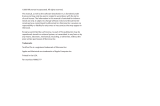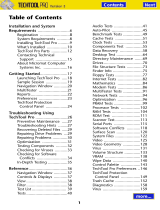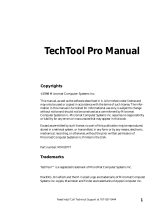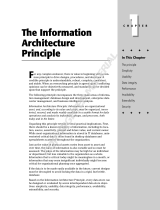Page is loading ...

i

ii
It is important that you register ATOMIC if you require technical support or wish to be notied of updates and upgrades. Online regis-
tration is the preferred way to register. It immediately places your information into our user base and saves you the inconvenience of
lling out, stamping, and mailing in the registration.
ATOMIC Registration
To register online go to:
http://www.micromat.com
Micromat Inc.
5331 Skylane Blvd.
Santa Rosa, CA 95403

iii
©2016 Micromat Incorporated. All rights reserved.
This manual, as well as the software described in it,
is furnished under license and may only be used or
copied in accordance with the terms of such license.
The information in this manual is furnished for
informational use only, is subject to change without
notice and should not be construed as a commit-
ment by Micromat Inc. Micromat assumes no re-
sponsibility or liability for any errors or inaccuracies
that may appear in this book.
Except as permitted by such license, no part of this
publication may be reproduced, stored in a retrieval
system, or transmitted, in any form or by any means,
electronic, mechanical, recording, or otherwise,
without the prior written permission
of Micromat Inc.
Trademarks
TechTool is a registered trademark of Micromat Inc.
TechTool Protogo and TechTool Pro are trademarks
of Micromat Inc. Apple and Macintosh are trade-
marks of Apple Inc.

iv
Table of Contents
About ATOMIC ....................................................................... 1
Getting Started...................................................................... 3
System Requirements ................................................................ 3
Installation .....................................................................................3
Using ATOMIC ........................................................................ 4
The ATOMIC Interface ................................................................4
Conguration ................................................................................ 5
Memory Module View ................................................................5
Running Tests ................................................................................6
Test Descriptions..........................................................................7
Contacting Technical Support ......................................... 9
About Micromat Inc...........................................................10

v

1
About ATOMIC
ATOMIC (Advanced Testing Of Memory ICs) is an
advanced memory testing utility for the Apple
Macintosh. It utilizes industry standard testing algo-
rithms, along with a few others to detect a variety of
memory faults. More importantly, ATOMIC reclaims
memory from other applications before beginning
testing, providing maximum memory for testing.
Random Access Memory (RAM) is one of the most
important components in your computer. Because
almost every operation done on a computer passes
through RAM, its accuracy is critical to the proper
operation of your computer. It is also one of the
components most susceptible to damage and
failure. This is because RAM upgrades are common,
hence RAM is handled more than most other com-
ponents. RAM is extremely susceptible to damage
from static electricity due to handling. Also, like any
chip, RAM is susceptible to overheating and thermal
uctuations.
Most other failures on your computer are more ob-
vious than a RAM failure. For example, if your hard
drive begins to malfunction, you will probably start
to see read and write errors appear via dialogs dis-
playing messages like, “Could not write le because
of a disk error.” However, RAM errors are much less
obvious since software uses dierent areas of RAM
at dierent times. RAM problems usually manifest
as unexplained and inconsistent crashes. There is no
clear error message indicating a RAM failure.
RAM is very susceptible to damage. Static, heat and
even normal air moisture can damage the RAM
used to store your Mac’s workspace. It is possible
that damaged RAM will prevent your Mac from
booting. However, the most common symptom of

2
bad RAM is much more subtle. Usually, the symp-
tom will be an inexplicable system freeze that is
dicult to reproduce consistently. Conventional
troubleshooting techniques won’t isolate the
problem. In fact, standard techniques will prove to
be more frustrating since the problem appears only
intermittently, leading you to believe you’ve solved
it only to discover later that the problem still exists
and manifests somewhere else.
Unlike physically damaged storage areas on your
hard drive that can be remapped by software so
that they are no longer used, faulty RAM bits can-
not be mapped out of use. While a technician with
adequate equipment and replacement components
can repair a RAM module, the cost to do this would
greatly outweigh the cost to replace the entire
module.
Using ATOMIC to test your RAM regularly can help
identify problems before they result in data corrup-
tion, providing the opportunity to replace faulty
modules. Because it includes an iterate function
that will test for an indeterminate amount of time
it can identify errors that will only appear with
extended, intensive use. And, because it includes
a wider variety of tests, it can potentially identify
edge-case errors which don’t normally occur.

3
Getting Started
System Requirements
• AMacintoshcapableofrunningOSX10.9orlater
• 4GBRAMorhigherrecommended.
(Specications subject to change without notice.)
Installation
ATOMIC is a self-contained application which does
not require a traditional installer application. To
install, simply drag the application icon to the Ap-
plications folder. Running the ATOMIC application
will install a couple of extra les:
/Library/PrivilegedHelperTools/com.micromat.
popHelper
/Library/LaunchDaemons/com.micromat.
popHelper.plist
~/Library/Application Support/ATOMIC
~ /Library/Preferences/com.micromat.ATOMIC.
plist
An uninstall application is included to remove the
extra les created by running ATOMIC. To uninstall,
simply double-click the uninstall application icon.

4
Using ATOMIC
The ATOMIC Interface
ATOMIC runs from an installation on your hard drive. To
launch the program, double-click the ATOMIC icon. After
the program has launched, you will see the main ATOMIC
window.
The window is divided into three panes with a start and
stop button at the bottom. The upper pane is the status
view. This is a visual summary of the current state of the ap-
plication. The two panes beneath the status view display
information about the installed RAM on the left, and an
area containing the test selection, options, and progress of
current tests on the right.

5
Conguration
The configuration pane consists of the lower right-hand
section of the ATOM interface. There are two circular
gauges which will count the number of passed and failed
test results while testing. The two linear gauges track the
current test progress and overall progress for all selected
tests, respectively. The Test Options column provides a
choice of which tests will be run.
Beneath the test options are two additional options: Stop
on Fault, and Iterate. Stop on Fault will suspend further
tests as soon as the first fault is found. Iterate will continue
running the selected tests in a loop until stopped by the
user, regardless of the number of faults found. If both Stop
on Fault and Iterate are selected, tests will run continu-
ously until the first fault is detected. Iterate can be useful for
stress testing memory.
Memory Module View
The memory module view displays the installed RAM ,

6
along with available slots. The DIMM addresses are listed to
the left of the modules, and the text to the right describes
the installed module.
Running Tests
Simply click the Start button to begin the selected tests.
ATOMIC will first allocate memory, retrieving as much
memory as possible from idle applications. It will then run
the selected tests through allocated RAM. The amount of
processor usage will be displayed in the CPU field.
NOTE: Testing memory is especially resource intensive,
and may cause your computer to respond slowly during
testing. Before starting testing, a reminder will display in
the status field that discourages using the computer until
testing has completed or been stopped.
Testing will stop automatically when the selected tests
have been completed, and the overall result will be dis-
played by the circular gauges. Testing may also be stopped
at any time by clicking the Stop button.
NOTE: The Stop button must be used to stop testing if the
Iterate option is selected.

7
Test Descriptions
ATOMIC includes ten dierent tests.
• StuckAddress—Ontherstpass,thistestwritesthe
address of each memory cell to that cell itself. On
the second pass, the address is read and veried to
ensure address space uniqueness.
• RandomValues—Thistestrstwritesaseriesof
random numbers into memory. Then, on the
second pass, the initial pattern is veried. Testing
with random values can help locate intermittent
problems. This test is also helpful in checking for
neighborhood pattern sensitivity. Over multiple
runs, it can help identify temperature sensitivity.
• SolidBits—Thistestwritesasolidbitpatterninto
memory, for example all 1s. The initial pattern is
checked and then complemented - switched to all
0s - and checked again. This checks that all addresses
are both readable and writable, and is useful for
detecting stuck-at faults.
• Checkerboard—Thistestmakesfourpasses.Therst
writes a pattern (dierent for each run). The second
pass reads/veries the pattern and writes the inverse
of the original pattern. The third round travels
downward back through memory as it reads/veries
the inverse and then writes the original pattern.
Finally, the fourth round veries the original pattern.
This checks for adjacent bit sensitivity - a situation in
which addresses other than the one being modied
are aected. It also veries the ecacy of memory
refresh.

8
• ExtendedMarchC—Thistestusesacomplex
algorithm consisting of six passes through memory.
It moves upwards through memory during the rst
three passes, writing and reading/verifying either 1s
or 0s. The next two passes move downward, reading/
writing 1s and 0s again (alternatively). The nal pass
may travel either direction, verifying that the last
write was successful. This test detects address faults,
coupling faults, stuck-at faults, stuck-open faults, and
transition faults.
• BitSpread—Thistestmovesa101patternacrossa
64-bit eld of 0s. The 0, a discharged state, between
the 1s, a charged state, can cause charged states
to occur in adjacent cells if RAM is faulty. The test
detects changes in adjacent cells by looking for 1s
where 0s are expected.
• WalkingOnes—Startingwiththebitpattern
00000001, each memory cell is written and read
to verify the pattern. The 1 is moved over by one
address and then the test is repeated for each
position. This test ensures that each bit can maintain
a value opposite of its neighboring bits, known as
an intra-word coupling fault. It can also nd stuck
address faults.
• WalkingZeroes—Thistestrepresentstheinverseof
Walking Ones. A pattern of 11111110 is the starting
pattern, and the 0 is moved through memory. This
test is also useful for detecting intra-word coupling
faults and stuck address faults.
• BitFlip—ThistestcombinestheWalkingOnesand
Zeroestestsbyusinganalternating10101010
pattern. Each bit (either a 1 or a 0) is changed to its
compliment as the test moves through memory,
testing to ensure that the pattern isn’t broken. This
test is also useful for detecting intra-word coupling
faults and stuck address faults.
• BlockSequence—ThistestissimilartotheWalking
OnesandZeroestests.Itmovesanexhaustive

9
series of patterns through a eld of either ones or
zeroes. (Two 1s through 0s, four 0s through 1s, etc.)
In addition to locating intra-word coupling faults, it
is also useful for detecting if RAM is susceptible to
neighborhood pattern sensitivity.

10
Contacting Technical Support
Micromat provides technical support to its custom-
ers by telephone or over the internet. For a current
listing of telephone numbers and other contact
information, please visit our website at www.mi-
cromat.com. Technical support is available Monday
through Friday (excluding public holidays), from
9:00 AM to 5:00 PM Pacic time.
• Email:[email protected]
• Phone:(707)566-3860
If you wish to contact technical support by tele-
phone you will need to have your ATOMIC serial
number and version number ready. Our automated
phone attendant will require you to enter this
information before connecting you to a technician.
Please be near your computer when you phone,
since our technicians will need to ask you questions
about your system, and will attempt to guide you
through solving any problems.
Please have the following information ready for the
support technician, and be sure to include it in any
email you send to Micromat.
• Abriefdescriptionofyourproblem.
• VersionnumberofyourATOMICsoftware.
• TypeofMacintoshandconguration,including
Processor and RAM installed. (Example: MacBook Pro
3 GHz Intel i7, 4 GB RAM, 2 TB internal hard drive.)
• VersionofMacOSXinstalled.

11
About Micromat Inc.
Micromat Incorporated has been developing Macintosh diagnostic utilities
since 1989. As the rst company to oer diagnostic products for Macintosh,
Micromat has pioneered many new technologies for helping Macintosh
users bring their computers back to life and to keep them running their
absolute best.
/











